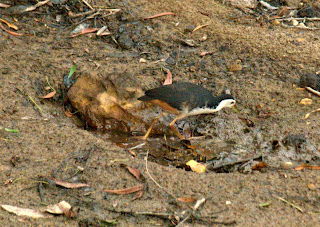I was also not so sure initially, but the 3-hr long trip certainly changed my view of the place I last visited almost 15 yrs ago.
Minutes after we arrived, a flock of Milky Storks (Mycteria cinerea) flew past overhead. Likely to be escapees, this a vulerable species largely due to the rapid loss of habitat. Not sure if we are still able to see wild ones in Singapore.
I made a casual comment that this Yellow Bittern (Ixobrychus sinensis) did not look natural since it was not in its usual surroundings of thick vegetation/ water edge, but was fully exposed.
My companions said I must have incurred its wrath as the bittern immediately took flight just as I ended my sentence with a full stop. Tsk, what a petty little fellow.
It was still in full view though, after landing on a tree some distrance away.
This tree looked as if it has tilted to one side under the weight of a flock of Asian Glossy Starlings (Aplonis panayensis) who decided to perch only on the left side of the tree.
It was near sunset, and flocks of Cattle Egrets (Babulcus ibis) flew 'home' after, what I assumed, a long day of adventure.
I have often seen Cattle egrets on patches of grassland, and sometimes by the MRT tracks, but never have I seen that many of them perched on a huge tree at any one time. I tried counting, and gave up after numerous attempts.
Some of them were in their breeding plumage with a rufous buff on their head and neck.
A good example of 鹤立鸡群 as it was not that difficult to see our tallest bird in Singapore - the Grey Heron (Ardea Cinerea) standing amongst the sea of white.
A golfer must have hit a bad shot, sent the ball flying towards the water, and startled the flock of Egrets. Though this resulted in a magnificient scene of a flock of Egrets circling the area, looking for a better and probably safer tree to perch and rest.
Nearby, a Collared Kingfisher's (Todiramphus chloris) attempts to capture our attention with its harsh laughter-like call were not futile. I embarked on my mission to 'hunt' it down and eventually found it perching on a bare branch. While the typical impression is that Kingfisher only eats fish (probably owing to its name), it also feeds on crustaceans, insects and small lizards. Interestingly, they have been observed to beat a large prey against the branch below devouring it.
Not an uncommon sight at marshes, the White-breasted Waterhen (Amaurornis phoenicurus) was foraging near the water edge, occasionally probing with its bill in the mud for food.
Apart from the plentiful species of birds, there were, of course, lots of plants too. Although its my second encounter with the Mickey Mouse plant (Ochna serrulata), I still could not fathom how it got its common name.
I was told to look closely at the sepals and imagine Micky. I did. But it still didnt work.
Then, I thought perhaps, it is the fruits that gave it its name. With some ingenious imagination, the fruits do resembles the looks of Mickey, to some extent.
After surfing the net, I learnt that the these green fruits are actually immature and will develop into round black and succulent fruits, surrounded by the bright red sepals. The black thus resembles the black ears of Mickey, and the red sepals - Mickey's face. Ah ha.... I shall remember to look for such an image when I next see the plant.
It was gangsterism by the pond as I engaged in a staring competition with the tortiose. =P I escaped unscathed, and ended the day in high spirits having had a great walk.
Pleased with our sightings of the day, I was also quietly ashamed of myself for having the perception that our Chinese Garden is a boring place with nothing much to offer. Certainly a great place for a slow and leisure walk with nature.
Oh yes, and one of my takeaways from the trip.. is that a fruit tree is very simly erm.. a tree that bears fruits. =P


















No comments:
Post a Comment